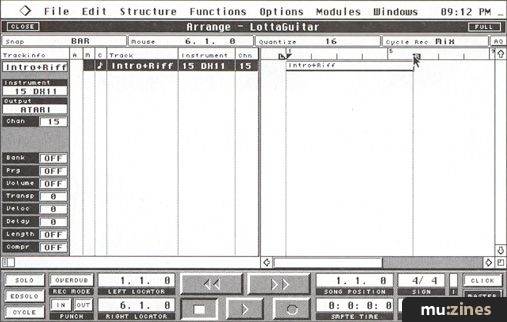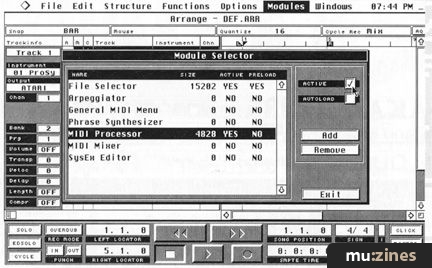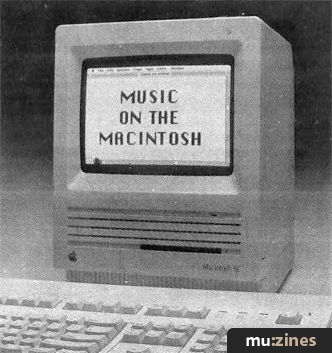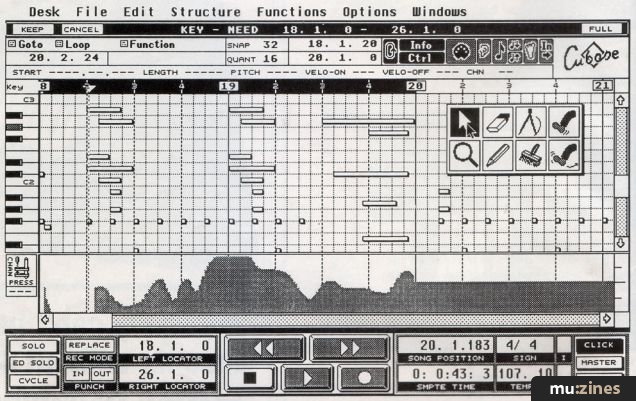Magazine Archive
Home -> Magazines -> Issues -> Articles in this issue -> View
Steinberg Pro24 III | |
Software for the Atari STArticle from Music Technology, July 1988 | |
The latest version of the industry-standard Atari ST sequencing package. Simon Trask finds out if software is fulfilling its promise to keep abreast of the times.
Computer-based sequencing software has always promised non-redundancy through software updates. Has Steinberg's Pro24, the original Atari ST MIDI sequencer, lived up to the promise?

ITS NOW ALMOST two years since MT reviewed Steinberg's Pro24, the first professional MIDI sequencing package for the Atari ST. During this time there has been a veritable explosion of ST-based MIDI software which has helped to put Atari's computer in pole position as far as musicians are concerned.
Other software companies haven't been shy about coming forward with their own sequencing packages, to the extent that there must now be some 15-20 ST-based sequencers of varying sophistication and cost. Yet Pro24 still has the biggest user base and the most solid presence in professional recording studios.
Clearly Steinberg have reaped rewards from the flagship status of their sequencer (the "early bird" syndrome), but for any sequencing package to survive in this fast-moving age it needs to adapt to current demands. This is where software updates come into their own, a fact which Steinberg always seem to have appreciated, as Pro24 has been through several updates since its original version. With the release of version III software it seemed high time for MT to survey the developments that have taken place in Pro24.
The Update
SO WHAT DOES Pro24 have to offer musicians nowadays? The number of tracks has remained a constant throughout the various software versions, and the front-end screen has remained essentially unchanged in conception - merely squeezing in more parameters to handle the greater sophistication of the software. Updates inevitably take their toll on computer memory, and as from version 2.0 the size of the program has been such that the 520ST doesn't have sufficient memory to run it.
Innovative features of the original Pro24 which have been retained through to the current version include the mastertrack (for specifying global tempo and time-signature changes) and the grid-edit screen. The mastertrack concept has now been expanded to include real-time recording of tempo changes by means of the data fader or +/- buttons.
Pro24 has stuck to its original method of track organisation, whereby patterns are created within individual tracks as a consequence of the way in which you go about recording. For example, if you decide to record a bass part in eight-bar sections then Pro24 will define them as a series of eight-bar patterns, simply as a matter of organisational convenience. Patterns within a track are automatically numbered, but you can also name them. For another track you might decide that it's time to record an extremely long and tedious synth solo; Pro24 will treat this as a single pattern.

Steinberg's intention has always been that Pro24 should be conceptually similar to a 24-track tape machine, with the obvious exception that Pro24 records MIDI data as opposed to audio data. Consequently, as with tape, you can start and stop recording at any position within a track, even if the track is otherwise blank. Unlike tape, you can use Pro24's Create function to create a series of empty patterns which reflect the structure of the piece you're about to record, name them accordingly, and then refer to the Track List or Where Am I? windows whenever you need to remind yourself of just where you are. In addition to providing organisational convenience within individual tracks, patterns can also be used as a means of transferring musical data between different tracks.
With the Arrange Song mode (debuted in the version 2.0 software, I believe) Steinberg departed from their favoured tape-style approach to adopt the more drum-machine-like approach of chaining patterns together. You can select any combination of Pro24's tracks to play around with by setting the relevant tracks to Sequence (as opposed to Tape). However, one track must be adopted as a reference track, while patterns in other tracks must align with the patterns in this track. Up to 64 patterns can be chained in this way.
Steinberg have attempted to provide a variety of approaches to recording and editing music. Following the now-famous Grid Edit system they added a Score Editor for those musicians who like to work with traditional notation, while now with version III they've added a Drum Editor for those musicians who like to work within a rhythmic framework (and I don't mean a four-poster or a hammock).
Like the Grid and Score Editors, the Drum Editor isn't divorced from Pro24's tracks - in fact it simply represents a specifically rhythmic way of envisaging a track. Basically you define a 32-instrument drum and percussion kit which is set up against a rhythm "grid" into which you record your percussive fancies in real or step time. It's just like recording into a pattern from the main screen, except that the Drum Editor is optimised for rhythmic playing. The principle isn't new (remember Fairlight's Page R?), but it's a welcome addition to an already flexible sequencer.
Incidentally, the Score Editor is no match for a fullblown scorewriting/transcribing program - but in fairness it isn't intended to be; if you require such a program then you should investigate Steinberg's Masterscore.
"Editing: Pro24 now has Score Editor for musicians who like to work with traditional notation and a Drum Editor for those who like to work within a rhythmic framework."
One of the most significant enhancements to Pro24 (just introduced in version III) is its ability to record on up to four tracks at a time. This can only be accomplished in Cycle Record mode (another development since the original software), the cycle being any portion of a track as defined by the left and right position locators.

Instead of recording into four tracks directly, you go via four "subtracks" - each subtrack being exclusively assigned to any one of the 24 tracks. This might seem a bit long-winded and over-complicated at first, but it does make sense after a while.
Each subtrack can be set to Mix, Auto or Normal record mode. Briefly, Mix is the loop-in-overdub approach typical of drum machines, Auto only punches in when you play a note, and Normal erases all data recorded in a previous pass as soon as you play a note.
Setting the flag Cycle:Multi-R to on allows incoming data on multiple MIDI channels to be allocated to four tracks via the four sub-tracks in the following way: channels 1,5,9 and 13 are routed via subtrack A, channels 2, 6, 10 and 14 via subtrack B, channels 3, 7, 11 and 15 via subtrack C, and channels 4, 8, 12 and 16 via subtrack D. This can be useful if, say, you're recording several MIDI'd players via a MIDI merge box.
Although Steinberg have stuck with 24 tracks despite the mega-track sequencers which have sprung up since (for instance, Master Tracks Junior offers 64 tracks for around a third of the price of Pro24), you can now effectively increase Pro24's 24-track capacity by using a feature known as Mixdown. This mixes down any number of tracks onto a single destination track. It's best to set each track to a different MIDI channel, because then you'll have the option to demix them (or Remix them, to use Steinberg's term) back onto separate tracks at a later date. It works like this: if you want a track to play back on multiple MIDI channels, you must set it to "No". You can also set a single MIDI channel (1-16) for playback, but this doesn't alter the channel assignments in memory.
Steinberg have developed Pro24's range of quantisation options quite considerably, coming up with some quasi-intelligent quantisation in the form of Over-quantise, which tries to tailor its quantising to your playing style, and additionally recognises chords and aligns them.
One of Pro24's most sophisticated developments has to be Logical Edit, which is accessed from either the Grid Edit or Score Edit screens. To quote from the manual, it "allows you to perform changes to your music based on logical or mathematical criteria, rather than musical". Essentially, Logical Edit allows you to perform arithmetic manipulations of MIDI notes and of other MIDI data such as pitch-bend, aftertouch, controllers and patches. You can also transform one type of MIDI event into another (pressure into a controller, for instance).

Though the more mathematically inclined among you would probably disagree, Logical Edit isn't one of Pro24's most intuitive features. Still, for those musicians prepared to investigate this "detour" down the alleyways of software sophistication it will no doubt prove to be an interesting journey.
"Recording: Although Steinberg have stuck with 24 tracks, you can now effectively increase Pro24's 24-track capacity by using a feature known as Mixdown."
Less visible, but possibly more readily useful, is the ability to create ten pairs of Left/Right Locator settings which can be called up instantly by pressing the STs Shift and Function keys. Similarly, you can define up to ten group mute settings of any combination of Pro24's tracks, and recall them by pressing the STs Alternate and Function keys.
Added MIDI features include remote control from a MIDI keyboard of sequencer functions such as Stop, Play and Record, the ability to "map" one controller onto another (so that, for instance, an incoming volume control can be outgoing as a pan control), and the ability to transmit a metronome pulse as a MIDI note (channel and note can be specified).
One area of MIDI communication which has grown significantly during the last couple of years is that of SysEx data dumps. In recognition of this development, Pro24 now includes a dump utility which allows you to send and receive SysEx data dumps, and to input and transmit a data request message if required. You can also define channel and ID numbers which Pro24 will then insert into SysEx data headers - highly useful if you're using, say, two MT32s and need to address them individually. You can also load in Steinberg Dump Modules, which contain the necessary communication protocols for specific instruments.
When Pro24 first came out, file transfer between different sequencers was a pipe dream. Now it's a reality - at least for software running on the same computer. Most MIDI software companies are now incorporating Standard MIDI Files disk storage into their sequencers and associated software, and Steinberg are no exception. Pro24 III adds Import and Export MIDI File capabilities, so now you can transfer your music to and from other ST MIDI software which incorporates Standard MIDI Files (such as Passport's Master Tracks sequencers and Intelligent Music's M).
Essential to any professional sequencing package is the ability to synchronise to tape. Since the arrival of Pro24, Steinberg have introduced the upmarket SMP24 SMPTE/MIDI processor (mentioned as a future product in MT's original Pro24 review) and budget Timelock SMPTE processor. Both units can be programmed from Pro24, while with an SMP24 connected to the Atari you can direct each of Pro24's tracks to any one of the unit's four MIDI Outs.

At the Frankfurt show this year Steinberg introduced their Tape Controller TC1 and software, which allows a tape machine (currently only the Fostex A and B series) to be controlled from the Atari ST. Pro24 III already has menu provision for tape control, so come a future software update you'll be able to control a tape machine from the sequencer.
Since the advent of Pro24, Steinberg have built up a healthy range of synth and sampler editing software, plus of course the Masterscore transcription and scorewriting software and DMP7 desktop mixing software. Now, as Steinberg employ the key copy-protection system, you run into problems if you want several programs in memory at the same time (the direction in which MIDI software usage appears to be going). Aside from the fact that you'll probably need more than a megabyte of RAM, you'll have to fork out £99 for a Steinberg key expander box which holds three keys at a time. The price of progress, I guess - but at least Steinberg are meeting the challenge.
Verdict
STEINBERG'S DEVELOPMENT OF Pro24 is a good illustration of the way in which software-based sequencers can be adapted to meet the demands of their users. The developments outlined above give a good idea of how the sequencer has changed, though there are also other changes which are a lot more subtle but nonetheless useful.
Importantly, Steinberg have concentrated on practical features which would seem to have arisen from the requests of Pro24 users, rather than arcane developments which will only please the converted - presumably in part a consequence of Pro24's adoption by many professional recording personnel. Also importantly, Steinberg have managed to maintain a continuity throughout the updates, so that users will know where they are rather than being faced with a steep (re)learning curve each time.
Finally, talking about learning curves, Steinberg have really got their act together when it comes to the manual. Clearly laid out, easy on the eye, thorough without being overwhelming, and surely written by a member of the Plain English society. When I recall the lamentable dot-matrix-printed German-English manuals that Steinberg used to come up with back in the days of Pro16 (now I'm showing my age), it fair brings a tear to my eye to see just how much things have improved.
Prices Pro24 III £285, Masterscore £325, SMP24 £919, Timelock £399; all prices include VAT
(Contact Details)
Also featuring gear in this article
An Old Pro - Steinberg Pro24 Amiga
(SOS Feb 91)
Macintosh or Atari?
(SOS Jan 88)
School's Out
(MIC Aug 89)
Software Tracking - Steinberg Pro24 Software
(EMM Sep 86)
Steinberg Pro 24 - SoftwareCheck
(IM Oct 86)
Steinberg Pro24 Version III
(SOS Aug 88)

Steinberg Software Page
(SOS May 88)
Steinberg Software Page
(SOS Jun 88)
Browse category: Software: Sequencer/DAW > Steinberg
Featuring related gear
Clash of the Titans
(MIC Oct 89)
Cubase 2.0
(SOS Dec 90)
Cubase In-depth
(MIC Jan 90)
Cubase MIDI Mixer - Programming Clinic (Part 1)
(SOS Oct 92)
Cubase MIDI Mixer - Programming Clinic (Part 2)
(SOS Nov 92)
Dirty Dozen
(MIC Jun 89)
Dream Sequences (Part 1)
(MX Dec 94)
Dream sequences (Part 2)
(MX Jan 95)
Dream Sequences (Part 3)
(MX Feb 95)
Dream sequences (Part 4)
(MX Mar 95)
Dream sequences (Part 5)
(MX Apr 95)
Dream sequences (Part 6)
(MX May 95)
Dream sequences (Part 7)
(MX Jun 95)
Hands On: Steinberg Cubase
(SOS Jan 92)
High Noon! - Steinberg 'Twelve' MIDI Recorder
(SOS Feb 89)
Browse category: Software: Sequencer/DAW > Steinberg
Publisher: Music Technology - Music Maker Publications (UK), Future Publishing.
The current copyright owner/s of this content may differ from the originally published copyright notice.
More details on copyright ownership...
Review by Simon Trask
Previous article in this issue:
Next article in this issue:
Help Support The Things You Love
mu:zines is the result of thousands of hours of effort, and will require many thousands more going forward to reach our goals of getting all this content online.
If you value this resource, you can support this project - it really helps!
Donations for November 2025
Issues donated this month: 0
New issues that have been donated or scanned for us this month.
Funds donated this month: £0.00
All donations and support are gratefully appreciated - thank you.
Magazines Needed - Can You Help?
Do you have any of these magazine issues?
If so, and you can donate, lend or scan them to help complete our archive, please get in touch via the Contribute page - thanks!




































